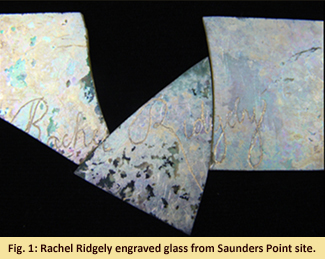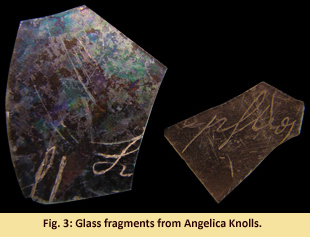Rachel Was Here
January 2010
By Annette Cook, MAC Lab Public Archaeology Asst.
 In 1968, a homeowner in Anne Arundel County, uncovered a suspected Colonial-era cellar pit while excavating for the installation of a swimming pool. Archaeologists were called in, and a salvage operation yielded a collection of artifacts dating to c. 1750, including ceramics, glass bottles, farm tools, a sword hilt and three pieces of window glass upon which was engraved the name "Rachel Ridgely" (Figure 1). The site, called Saunders Point, is known to have been part of a plantation owned by the prominent Saunders family.
In 1968, a homeowner in Anne Arundel County, uncovered a suspected Colonial-era cellar pit while excavating for the installation of a swimming pool. Archaeologists were called in, and a salvage operation yielded a collection of artifacts dating to c. 1750, including ceramics, glass bottles, farm tools, a sword hilt and three pieces of window glass upon which was engraved the name "Rachel Ridgely" (Figure 1). The site, called Saunders Point, is known to have been part of a plantation owned by the prominent Saunders family.
A quick look into genealogical records finds that there were several ladies named Rachel Ridgely, either by birth or by marriage, living in the area during the late 17th century and throughout the 18th century. Any of these, or some other, may have been the one who wrote, or was written of, in the Saunders Point window.
 History shows that the etching of names, and indeed whole verses on window panes, was a common practice in 16th and 17th century England (Targoff, 2008: 67). The Princess Elizabeth is said to have inscribed the following words during her captivity at Woodstock in 1554-1555: "Much is suspected of me/ Nothing proved can be. Quoth ELIZABETH, Prisoner" (Fumerton and Hunt, 1999: 332; Fleming, 2001: 55-56). Later as queen, the same Elizabeth and Sir Walter Raleigh shared a bit of conversation inscribed in glass when Raleigh wrote in a window at court, "Fain would I climb yet fear I to fall." Underneath, Elizabeth inscribed in reply "If thy heart fails thee, climb not at all" (Fumerton and Hunt, 1999: 333; Fleming, 2001: 56). Raleigh reportedly used a "writing ring," which was a ring with a pyramid shaped diamond set with the pointed end up (Figure 2). Such rings were produced by jewelers especially for writing on glass (Fleming, 2001: 55; Targoff, 2008: 67).
History shows that the etching of names, and indeed whole verses on window panes, was a common practice in 16th and 17th century England (Targoff, 2008: 67). The Princess Elizabeth is said to have inscribed the following words during her captivity at Woodstock in 1554-1555: "Much is suspected of me/ Nothing proved can be. Quoth ELIZABETH, Prisoner" (Fumerton and Hunt, 1999: 332; Fleming, 2001: 55-56). Later as queen, the same Elizabeth and Sir Walter Raleigh shared a bit of conversation inscribed in glass when Raleigh wrote in a window at court, "Fain would I climb yet fear I to fall." Underneath, Elizabeth inscribed in reply "If thy heart fails thee, climb not at all" (Fumerton and Hunt, 1999: 333; Fleming, 2001: 56). Raleigh reportedly used a "writing ring," which was a ring with a pyramid shaped diamond set with the pointed end up (Figure 2). Such rings were produced by jewelers especially for writing on glass (Fleming, 2001: 55; Targoff, 2008: 67).
 The Maryland Archaeological Conservation Lab collection also includes two pieces of glass from Angelica Knolls, in Calvert County, with partial words inscribed upon them (Figure 3). The message will probably never be known, and it will remain a tantalizing bit of historical graffiti, much like "Rachel Ridgely" will probably remain a mystery person with an unknown purpose.
The Maryland Archaeological Conservation Lab collection also includes two pieces of glass from Angelica Knolls, in Calvert County, with partial words inscribed upon them (Figure 3). The message will probably never be known, and it will remain a tantalizing bit of historical graffiti, much like "Rachel Ridgely" will probably remain a mystery person with an unknown purpose.
Why would someone take the time to etch their name or other words into glass? Over thirty thousand years ago people began leaving handprints on cave walls using charcoal dust blown through a straw. Perhaps then, it is a simple human desire to leave a token of oneself. To set words in something firm and to tell the world "I existed, I was here."
| References |
|
| Beadle's Monthly |
| 1867 |
Beadle's Monthly, Volume 1, page 263, Courtesy of Don Rittner. |
|
| Fleming, Juliet |
| 2001 |
Graffiti and the Writing Arts of Early Modern England. Philadelphia, PA: University of Philadelphia Press. |
|
| Fumerton, Patricia and Simon Hunt |
| 1999 |
Renaissance Culture and the Everyday. Philadelphia, PA: University of Philadelphia Press. |
|
| Montaperto, Kristin |
| 2009 |
Personal Communication. |
|
| Targoff, Ramie |
| 2008 |
John Donne, Body and Soul. Chicago, IL: University of Chicago Press. |
|